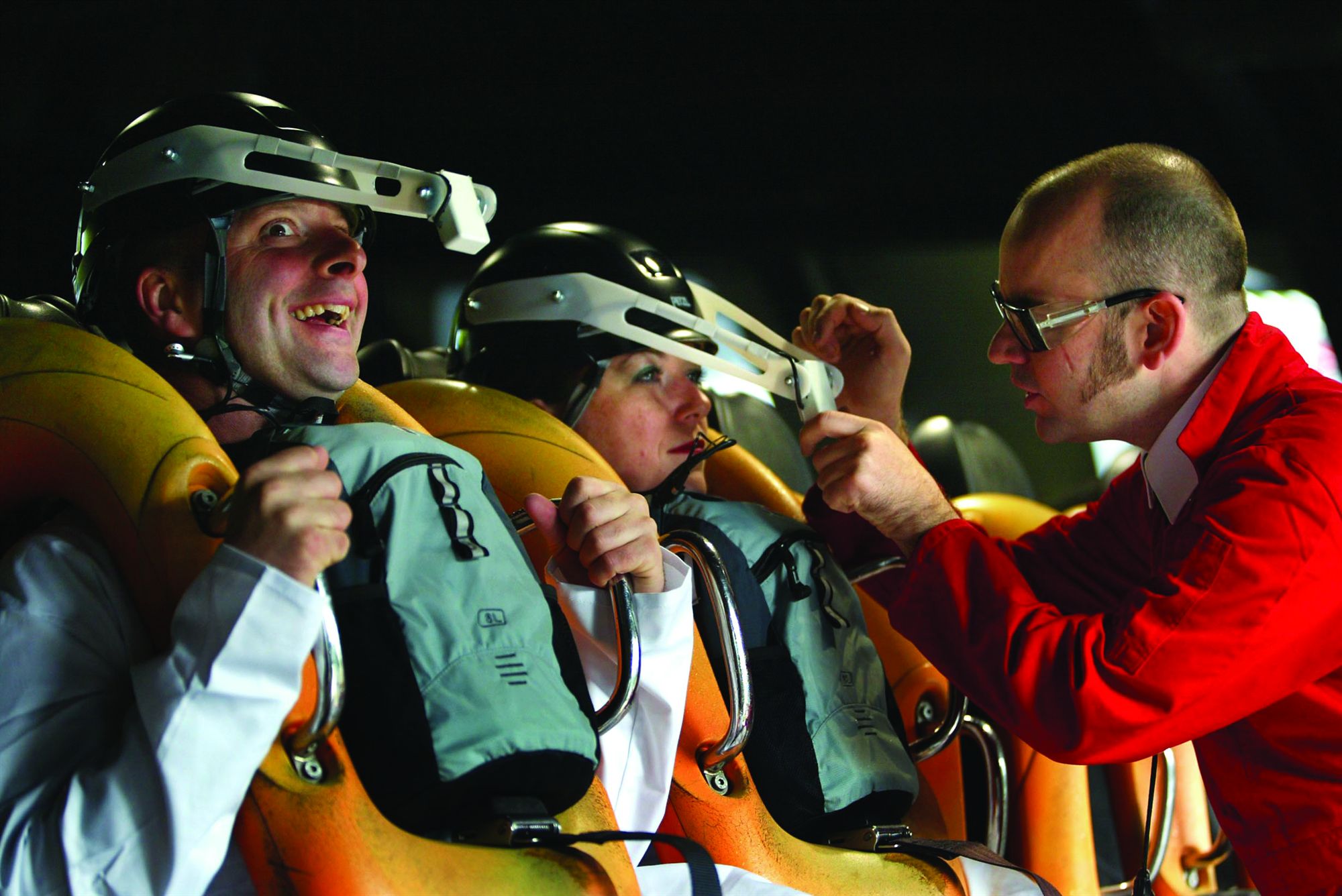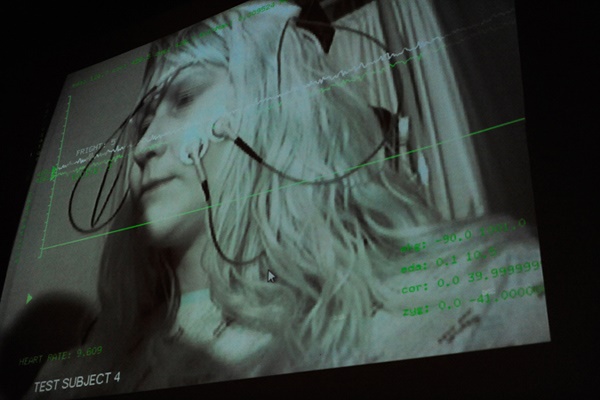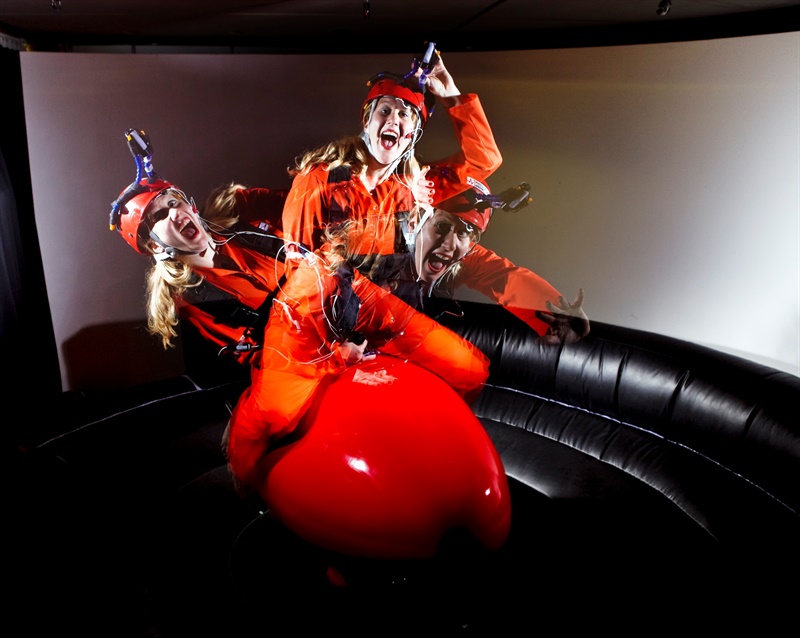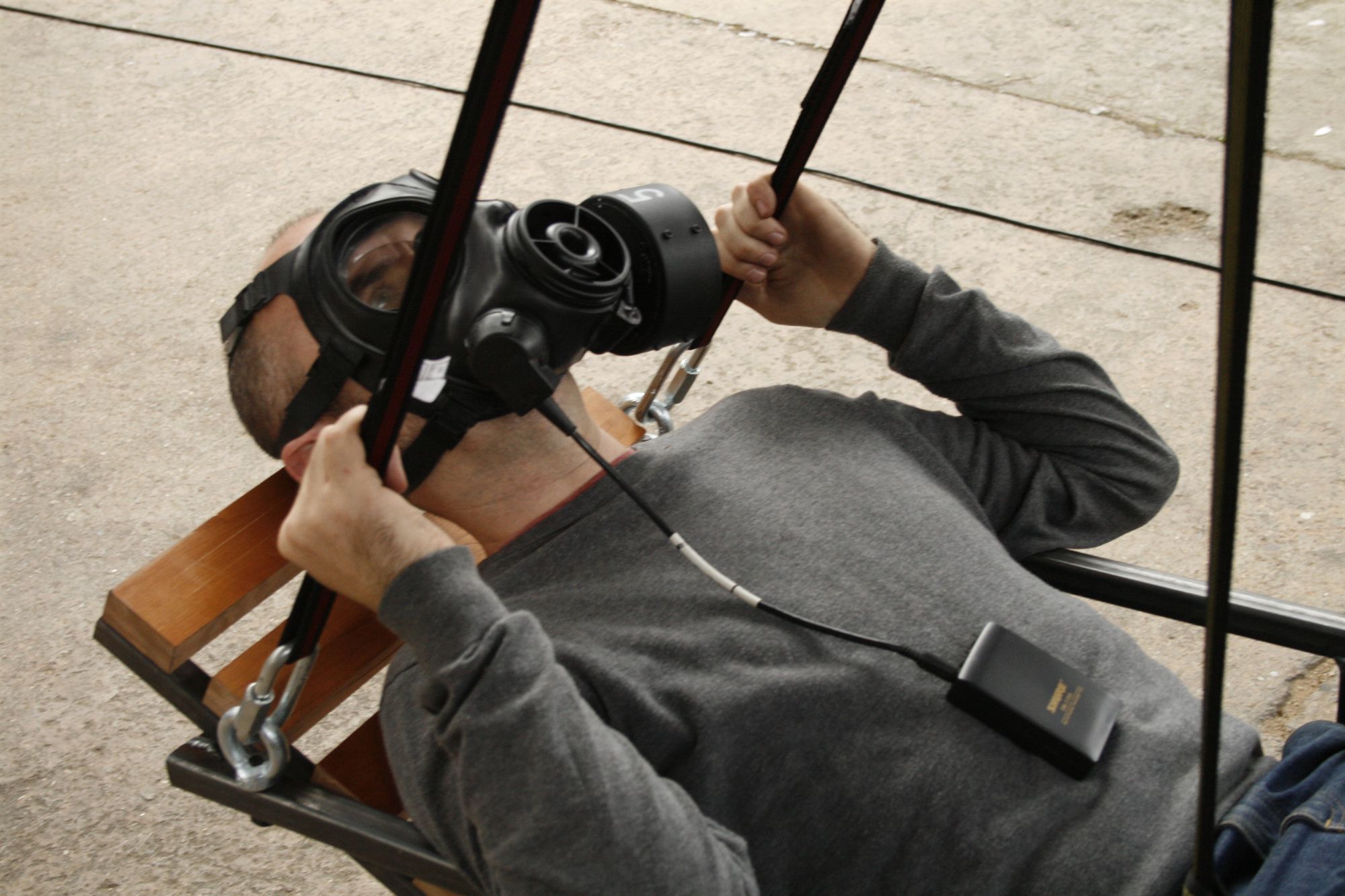Engineering thrill
Experimental practice led research in the Creative Industries produces thrilling, and sometimes uncomfortable, academic results
Brendan Walker calls himself an “experimental engineer”, a job description that sounds alarming if you’re used to thinking that engineers build bridges. Walker’s actual work for Horizon Digital Economy Research and the Mixed Reality Laboratory is physically safer for his subjects: he studies the use of biodata to enhance entertainment experiences. He is practitioner as much as researcher, aiming to give spectators and participants an added dimension to how they view and experience anything from movies to theme park rides.
“From a computer science perspective, the experiments we construct very often don’t have the amount of data points that would be needed to say something of statistical significance,” he says. “But we do look at how that data is used in terms of biofeedback. So we’re creating new entertainment experiences – but we’re more interested in how people consume that data and how they understand it.”
Walker’s work is unusual in several respects. First of all, as a practitioner he chooses projects “pure” scientists might not touch. Second, Walker’s entertainment experiments allow ethics questions to emerge that will be pertinent to the science community as monitoring devices become pervasive (see box). On balance, he says, “We’ve done studies that have 20 people who’ve all had biodata monitored and we can do psychometric profiling on some visitors to theme parks and say what rides people might like to go on. We’ve done research papers – but that’s not only where the value is. The value is also to the creative industries and the arts and humanities community.”
The biodata Walker works with is captured from live participants via sensors applied externally: heart rate, blood pressure, pupil dilation, facial expressions, breathing rate and depth, sweat on the skin (measured as “galvanic skin response” or “skin conductance”), muscle actions, and so on. Walker uses these in a variety of ways: to study audience reactions more closely; to play back to participants to enhance their reactions; or to display to spectators or those awaiting their turn to heighten their excitement and anticipation. In some projects the audience is left to draw their own conclusions from the streamed data; in a couple Walker acted like a sports commentator to present and analyse the data they were seeing.
The ideas generated by each of the projects outlined below has led to the next. A few have led to academic papers in conjunction with fellow Horizon researchers such as Steve Benford and Derek McAuley. For example http://doi.acm.org/10.1145/1978942.1979199 Automics: souvenir generating photoware for theme parks was presented at CHI ’11, where it won the best paper award.
Oblivion (2007)

https://www.youtube.com/watch?feature=player_embedded&v=RP_Cz0HKegI This Alton Towers vertical drop roller coaster was the venue for putting some 60 volunteers through a series of psychological profiling tests to assess each rider’s experience and thrill-seeking tendencies. Then, each was outfitted with devices such as a heart monitor, accelerometer, face camera, and galvanic skin sensor before being sent on the ride. This project clearly demonstrated that biodata can provide an engaging experience for spectators, especially when compared to their traditional role of ‘holding the bags’. A paper based on this work, http://doi.acm.org/10.1145/1357054.1357238 Performing thrill: designing telemetry systems and spectator interfaces for amusement rides, was presented at CHI ’08.
Self-examination (2009)

In this http://www.thrilllaboratory.com/experience/selfexamination.html top experiment, produced for a horror film festival, Walker worked with a sculptor, who made a wheelchair like an instrument of torture from the 1977 movie Demon Seed. The winners of a competition were strapped into the wheelchair and hooked up to its embedded medical monitoring sensors, then wheeled into the the auditorium to watch a movie. The data were https://www.youtube.com/watch?v=CQq2EBWddf4 broadcast live outside the cinema. “The idea was to try to reveal both the horrors that people were experiencing inside the auditorium and also elicit empathy with the audience members from the passers-by, who got a sense of the content being broadcast inside,” says Walker. This was his first use of streaming biodata to create a vicarious experience in which spectators outside gained insight into the psychological state of the viewer inside.
Bucking Bronco (2009)

https://www.youtube.com/watch?v=Iz7ZM7EnGVQ This project began by allowing the ride’s operator to change the ride’s buck rate and spin based on information gleaned from the participants’ galvanic skin response and heart rate data. The participants were all actors playing the role of bankers from different sectors who sat with sacks over their heads and do the ride when picked by spectators. A later rerun of the Bronco, produced by colleague Joe Marshall, removed the ride operator and instead assigned the decision-making power to a computer programmed to optimise the system. The ride became a game: the rate and amplitude of riders’ breathing, captured by monitors, controlled the buck. “They had to beat the system by staying on the ride – but they also had to score,” Walker says. A paper based on this work, http://doi.acm.org/10.1145/1690388.1690463 The Bronco: a proof-of-concept adaptive fairground ride, was presented at ACE ’09.
Breathless (2010)

Breathing also controlled http://www.thrilllaboratory.com/experience/breathless.html Breathless, a large swing tens of metres high in a warehouse. In this case, breathing at the harmonic frequency of the swing would push the swing higher. Walker hoped that the swing would get so high (and scary) that eventually the rider would start to hyperventilate and stop putting in energy at the right frequency, at which point the ride’s amplitude would start dropping. “There’d be some magic balance point that would be different for everyone.” In practice, the system never achieved a sufficiently scary amplitude, and so the ride was reformulated along lines suggested by the painting “The Swing”, by Jean-Honoré Fragonard. “The Swing” shows three protagonists – a woman, an older man pushing her on the swing, and her lover, hidden in the bushes. The people in the ride queue were issued with gas masks to anonymise them, and then rotated through the three roles. “At one point you were maybe controlling the pleasure of your partner – or it might be a stranger with two people who know each other intimately.” Overall, he says, “It became much more about the thrill of controlling somebody else’s pleasure. It was capturing the biodata that allowed the control to happen.” Two papers came out of this work, both for CHI ’11: one, http://doi.acm.org/10.1145/1979742.1979609 The gas mask: a probe for exploring fearsome interactions, discussed the use of gas masks in such situations; the second, http://dl.acm.org/citation.cfm?doid=1978942.1978955 Breath control of amusement rides , considered the prospects, present and future, for the use of breath control.
Experiment Live (2011)

https://www.youtube.com/watch?v=AhdQD8tZo7o&feature=youtu.be
This project for the Mayhem Horror Film Festival looked back at Steven Volk’s 1992 BBC programme Ghost Watch, which purported to be a real-time investigation of a haunted house but in reality was entirely scripted. Walker spent six months building the character of a ghost haunting a tea shop across from the cinema. The live event wired up a member of the public with biomedical monitoring equipment and filmed them exploring the heavily staged walk-through while broadcasting the investigation experience to a studio audience at the cinema. The new element was the test of using biodata to enhance the audience’s empathy with the on-screen characters. In interviews afterwards, audience members indicated that often they didn’t understand what the biodata was telling them, despite having been presented with a brief explanation. “They still felt the biodata were quite abstract. What they did like was the idea that clearly some science was being performed and the data in their mind was offering some kind of veracity. A paper based on this work, http://dl.acm.org/citation.cfm?id=2212787 The Machine in the Ghost: Augmenting Broadcasting with Biodata, appeared in CHI EA ’12.
Short subjects (2012): Short recent projects have attempted to solve this last problem. For Nissan, Walker created several two to three-minute films about its new https://www.youtube.com/watch?v=FAPiiu6S600built to thrill” Juke car. The clips of the thrill-seekers driving the car were so short that Walker had to develop a graphical language to display the data. “What we lost in storytelling we did with a more compelling graphic visualisation of the data[BW8] .” A second advertising project – for the 2012 horror film [BW9] Sinister – built on this to present data to https://www.youtube.com/watch?v=t-Yk1MpkNUY highlight how scary the film was.
As a result of this latter effort, Walker is working on a paper covering the challenges of using biodata in filmmaking. In doing so, he’s encountered criticism that advertising shouldn’t be discussed in a serious research report.
“I was kind of surprised,” says Walker, “and slightly annoyed. When I’ve done work around theme parks I’ve been asked this: ‘Shouldn’t you be concentrating on medical research into phobias and fears?’ My business is entertainment and the digital economy. Understanding these things is important. It’s not just random. It’s worthwhile to study them in an entertainment context.”
Sidebar: Ethics
New information streams raise new ethics questions. An unexpected outcome of Walker’s monitoring experiments is a series of nascent moral dilemmas that one day soon we will all face as implanted medical devices and self-quantifying gadgets come into mass use. When, for example, a participant starts screaming in apparent distress, as happened when Walker deployed infrared night vision cameras to relay experiences from inside the Saw-based horror maze at Thorpe Park, what should the operators do when a spectator starts screaming for a panicked loved one to be let out? Knowing the participant could walk out at any time, Walker decided to leave her in place, a decision that turned out to be justified. But what if the displayed data showed an unsuspected medical condition? “What is the duty of care?” Walker asks.
This sort of question inspired the paper http://machen.mrl.nottingham.ac.uk/~sdb/research/downloadable%20papers/Uncomfortable%20interactions.pdf
Uncomfortable Interactions (Proceedings of CHI 2012), written with co-authors Steve Benford, Chris Greenhalgh, Gabriella Giannachi1, Joe Marshall, and Tom Rodden, which discusses the ethics of discomfort in art and entertainment in the paper. The key issue is that ethically, researchers are supposed to protect subjects from being uncomfortable – but on a thrill ride being uncomfortable is part of the point.
“My feeling is that if you think about it as entering a theme park or fairground site, there’s an unwritten contract when you go in that you expect to experience the unexpected, and sometimes you expect to feel some uncomfortable things.”
Broadcasting the data as a shared spectacle adds another complication: the underlying condition may be revealed to medical practitioners in the audience who can read the data with greater expertise.
“My approach until now has been that in TV we’re used to looking at and listening to people and their physical manifestation. People have spotted things like melanomas and other medical conditions. And the TV channel is not expected to spot them.”
Walker notes that ethics really isn’t his field of study, though, “I’m interested in the tensions these questions create.” He believes the proliferation of devices, from Fitbits to implanted heart monitors, will force wider discussion.


















